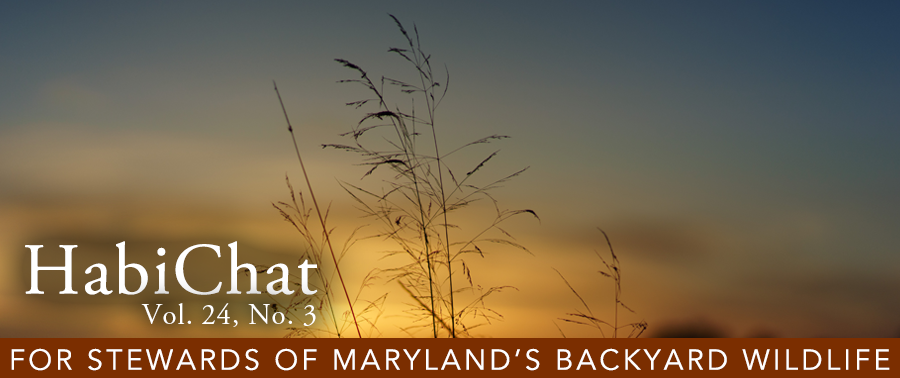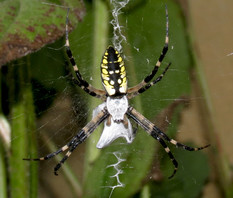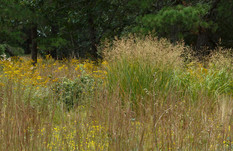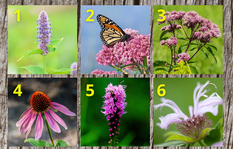
|
Vol. 24, No. 3 | Fall 2020
|

Happy Fall!
Spending more time at home means I’m spending more time in the backyard. I have been in awe at the sights I have missed over the years. Lately, I have been watching the backyard monarchs as if they were my own children! As the days get shorter, here are a few things to consider this time of year:
- Skip the fall clean-up to help local wildlife
- Consider sowing seeds
- Fuel fall migrants
I’m also excited to announce the new Wild Acres public events page which will feature upcoming webinars presented by the Wildlife and Heritage Service. In addition, the Gardening for Pollinators webinar is now available on-demand. HabiChat subscribers will receive webinar updates as they are scheduled.
Furthermore, if you are in need of trees and shrubs for conservation or lumber, check out the Maryland State Tree Nursery which will soon be accepting orders for Spring 2021.
In this issue, you can learn about the lovely black and yellow garden spiders which can be seen this time of year, as well as information on the vigorous, native switchgrass. Additional articles include information on the importance of warm season grasses and why leaving flower stems up through the winter helps pollinators. Finally, learn about a new class on wildlife management being offered by the University of Maryland Extension.
Happy Habitats,
Kerry Wixted
|
|
|
|

Native Wildlife: Black and Yellow Garden Spider
More than 250 species of spiders can be found in Maryland and one of the largest and more visible species is the
black and yellow garden spider (Argiope aurantia). Also affectionately known as the writing spider, the black and yellow garden spider fashions an intricate zig-zag pattern in the center of its web. This extra weave is known as a stabilimentum. The purpose of the stabilimentum is still not known. Its reflection helps larger animals (like ourselves) see the web to avoid walking through, but it also may help to attract smaller prey. Photo by Kerry Wixted.
|

Native Plant: Switchgrass
Switchgrass (Panicum virgatum) is a native, warm season grass that is an excellent replacement for invasive Chinese silvergrass (Miscanthus sinensis). This large, bunching grass grows 3-7 feet high and has a 2-3 foot spread. In addition, its extensive root system grows 5-6 feet deep, making it a great plant to assist with stabilizing banks. The roots also help it to tolerate droughts and floods too! Photo by Matt Levin CC by SA 2.0.
|

Warm Season Grasses for Wildlife
Warm season grasses are grasses that grow best during the summer (June-August) and often form large clumps. These grasses provide excellent wildlife habitat, in addition to erosion control. Warm season grasses typically are tall plants with large root systems that help keep soil in place. Photo of switchgrass and bluestem meadow by Tom Potterfield CC by NC SA 2.0.
|

Creating Habitat for Stem-nesting Bees
Did you know? About 30% of Maryland’s native bees nest in tubes and tunnels. Very few of these species are able to excavate their own nests too. This article will cover how to create habitat for bees that nest in stems of flowers and woody plants.
|
Enhance your property for wildlife with the Wildlife Management Online Course!
The University of Maryland Extension will offer its Wildlife Management Online Course for the spring 2021 semester. Learn about ecological concepts, predator-prey relationships, biodiversity, hazards and diseases, habitat assessment techniques, managing forests for wildlife, and much more! This course provides you with the tools to develop the framework for a wildlife management plan for your property.
The online course runs Feb. 1 - May 15, 2021. Registration opens November 1, 2020.
To learn more and register for the course, visit the University of Maryland Extension website.
|
|
|
|
|
Wild Acres is a voluntary program that encourages residents to create backyard wildlife habitat.
For more winter tips and tricks, check out the HabiChat archives.
|
|
Home News Licenses Photo Contest Nursery Park Reservations Store
|
|
|